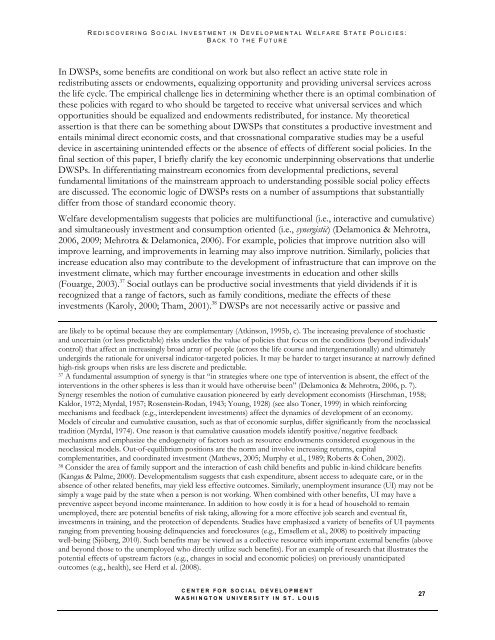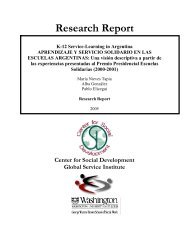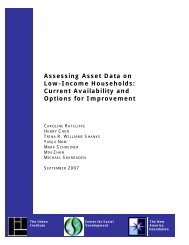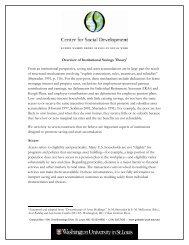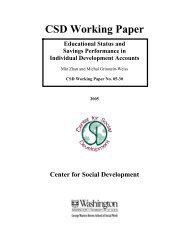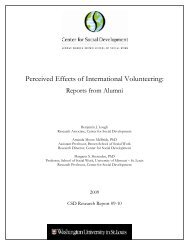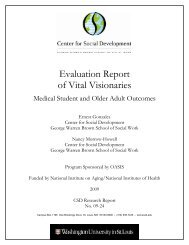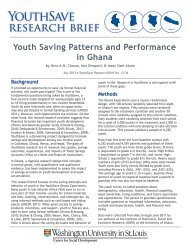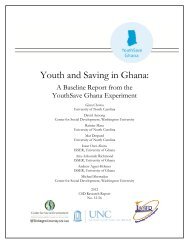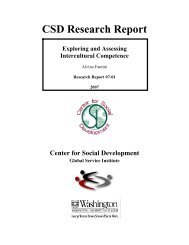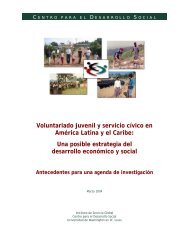Rediscovering social investment in developmental welfare state ...
Rediscovering social investment in developmental welfare state ...
Rediscovering social investment in developmental welfare state ...
Create successful ePaper yourself
Turn your PDF publications into a flip-book with our unique Google optimized e-Paper software.
R E D I S C O V E R I N G S O C I A L I N V E S T M E N T I N D E V E L O P M E N T A L W E L F A R E S T A T E P O L I C I E S :<br />
B A C K T O T H E F U T U R E<br />
In DWSPs, some benefits are conditional on work but also reflect an active <strong>state</strong> role <strong>in</strong><br />
redistribut<strong>in</strong>g assets or endowments, equaliz<strong>in</strong>g opportunity and provid<strong>in</strong>g universal services across<br />
the life cycle. The empirical challenge lies <strong>in</strong> determ<strong>in</strong><strong>in</strong>g whether there is an optimal comb<strong>in</strong>ation of<br />
these policies with regard to who should be targeted to receive what universal services and which<br />
opportunities should be equalized and endowments redistributed, for <strong>in</strong>stance. My theoretical<br />
assertion is that there can be someth<strong>in</strong>g about DWSPs that constitutes a productive <strong><strong>in</strong>vestment</strong> and<br />
entails m<strong>in</strong>imal direct economic costs, and that crossnational comparative studies may be a useful<br />
device <strong>in</strong> ascerta<strong>in</strong><strong>in</strong>g un<strong>in</strong>tended effects or the absence of effects of different <strong>social</strong> policies. In the<br />
f<strong>in</strong>al section of this paper, I briefly clarify the key economic underp<strong>in</strong>n<strong>in</strong>g observations that underlie<br />
DWSPs. In differentiat<strong>in</strong>g ma<strong>in</strong>stream economics from <strong>developmental</strong> predictions, several<br />
fundamental limitations of the ma<strong>in</strong>stream approach to understand<strong>in</strong>g possible <strong>social</strong> policy effects<br />
are discussed. The economic logic of DWSPs rests on a number of assumptions that substantially<br />
differ from those of standard economic theory.<br />
Welfare <strong>developmental</strong>ism suggests that policies are multifunctional (i.e., <strong>in</strong>teractive and cumulative)<br />
and simultaneously <strong><strong>in</strong>vestment</strong> and consumption oriented (i.e., synergistic) (Delamonica & Mehrotra,<br />
2006, 2009; Mehrotra & Delamonica, 2006). For example, policies that improve nutrition also will<br />
improve learn<strong>in</strong>g, and improvements <strong>in</strong> learn<strong>in</strong>g may also improve nutrition. Similarly, policies that<br />
<strong>in</strong>crease education also may contribute to the development of <strong>in</strong>frastructure that can improve on the<br />
<strong><strong>in</strong>vestment</strong> climate, which may further encourage <strong><strong>in</strong>vestment</strong>s <strong>in</strong> education and other skills<br />
(Fouarge, 2003). 37 Social outlays can be productive <strong>social</strong> <strong><strong>in</strong>vestment</strong>s that yield dividends if it is<br />
recognized that a range of factors, such as family conditions, mediate the effects of these<br />
<strong><strong>in</strong>vestment</strong>s (Karoly, 2000; Tham, 2001). 38 DWSPs are not necessarily active or passive and<br />
are likely to be optimal because they are complementary (Atk<strong>in</strong>son, 1995b, c). The <strong>in</strong>creas<strong>in</strong>g prevalence of stochastic<br />
and uncerta<strong>in</strong> (or less predictable) risks underlies the value of policies that focus on the conditions (beyond <strong>in</strong>dividuals‘<br />
control) that affect an <strong>in</strong>creas<strong>in</strong>gly broad array of people (across the life course and <strong>in</strong>tergenerationally) and ultimately<br />
undergirds the rationale for universal <strong>in</strong>dicator-targeted policies. It may be harder to target <strong>in</strong>surance at narrowly def<strong>in</strong>ed<br />
high-risk groups when risks are less discrete and predictable.<br />
37 A fundamental assumption of synergy is that ―<strong>in</strong> strategies where one type of <strong>in</strong>tervention is absent, the effect of the<br />
<strong>in</strong>terventions <strong>in</strong> the other spheres is less than it would have otherwise been‖ (Delamonica & Mehrotra, 2006, p. 7).<br />
Synergy resembles the notion of cumulative causation pioneered by early development economists (Hirschman, 1958;<br />
Kaldor, 1972; Myrdal, 1957; Rosenste<strong>in</strong>-Rodan, 1943; Young, 1928) (see also Toner, 1999) <strong>in</strong> which re<strong>in</strong>forc<strong>in</strong>g<br />
mechanisms and feedback (e.g., <strong>in</strong>terdependent <strong><strong>in</strong>vestment</strong>s) affect the dynamics of development of an economy.<br />
Models of circular and cumulative causation, such as that of economic surplus, differ significantly from the neoclassical<br />
tradition (Myrdal, 1974). One reason is that cumulative causation models identify positive/negative feedback<br />
mechanisms and emphasize the endogeneity of factors such as resource endowments considered exogenous <strong>in</strong> the<br />
neoclassical models. Out-of-equilibrium positions are the norm and <strong>in</strong>volve <strong>in</strong>creas<strong>in</strong>g returns, capital<br />
complementarities, and coord<strong>in</strong>ated <strong><strong>in</strong>vestment</strong> (Mathews, 2005; Murphy et al., 1989; Roberts & Cohen, 2002).<br />
38 Consider the area of family support and the <strong>in</strong>teraction of cash child benefits and public <strong>in</strong>-k<strong>in</strong>d childcare benefits<br />
(Kangas & Palme, 2000). Developmentalism suggests that cash expenditure, absent access to adequate care, or <strong>in</strong> the<br />
absence of other related benefits, may yield less effective outcomes. Similarly, unemployment <strong>in</strong>surance (UI) may not be<br />
simply a wage paid by the <strong>state</strong> when a person is not work<strong>in</strong>g. When comb<strong>in</strong>ed with other benefits, UI may have a<br />
preventive aspect beyond <strong>in</strong>come ma<strong>in</strong>tenance. In addition to how costly it is for a head of household to rema<strong>in</strong><br />
unemployed, there are potential benefits of risk tak<strong>in</strong>g, allow<strong>in</strong>g for a more effective job search and eventual fit,<br />
<strong><strong>in</strong>vestment</strong>s <strong>in</strong> tra<strong>in</strong><strong>in</strong>g, and the protection of dependents. Studies have emphasized a variety of benefits of UI payments<br />
rang<strong>in</strong>g from prevent<strong>in</strong>g hous<strong>in</strong>g del<strong>in</strong>quencies and foreclosures (e.g., Emsellem et al., 2008) to positively impact<strong>in</strong>g<br />
well-be<strong>in</strong>g (Sjöberg, 2010). Such benefits may be viewed as a collective resource with important external benefits (above<br />
and beyond those to the unemployed who directly utilize such benefits). For an example of research that illustrates the<br />
potential effects of upstream factors (e.g., changes <strong>in</strong> <strong>social</strong> and economic policies) on previously unanticipated<br />
outcomes (e.g., health), see Herd et al. (2008).<br />
C E N T E R F O R S O C I A L D E V E L O P M E N T<br />
W A S H I N G T O N U N I V E R S I T Y I N S T . L O U I S<br />
27


